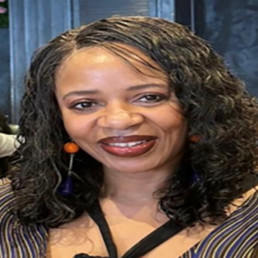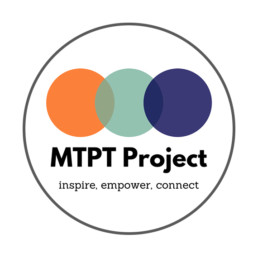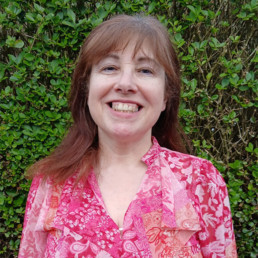My Becoming

Written by Caroline Anukem
Caroline Anukem is Equity, Diversity and Inclusion Lead at Beaconsfield High School in the UK. She is a driving force, a change-maker, and a relentless advocate for equity.
Once upon a time, in the 1980s village of Woolton, Liverpool, my educational journey began at Notre Dame, a Roman Catholic Grammar School with a simplicity and homogeneity that defined the era. Diversity, an unfamiliar term, seldom found its way into our vocabulary. Inclusivity, if acknowledged at all, meant conforming to a narrow mould. The notion of an EDI Lead was beyond imagination, and conversations about inclusion were but a whisper in the wind. I will definitely one day take a trip down memory lane and share my experiences.
Fast forward to the present day, where the quaint village experience meets the vibrant landscape of Beaconsfield High School. Here, I am privileged to be the school’s EDI Lead. Over the years we have witnessed an extraordinary transformation. Our school, once bound by conformity, now embraces the range of backgrounds, cultures, and identities. Diversity is not just acknowledged; it is a cause for celebration. This celebration of diversity and citizenship was ignited during our inaugural Global Citizens Week celebration. Inclusion is not just a buzzword; it is consciously embedded into the very aspect of our educational system.
The positives of this transformation are as abundant as the perspectives, worldviews, and lifestyles our students now encounter. They merge a rich foreword thing, diverse and inclusive learning experiences, the invaluable lessons of empathy, respect, and the strength derived from unity in the face of diversity. We are not merely preparing them for a world where these qualities are admirable; we are preparing them for a world where these qualities are essential. Yet, as we bask in the glow of progress, the journey towards true equity and inclusion continues. Barriers, some dismantled, others still standing, remind us that our work is far from over. As the EDI Lead, I recognise the need for more diversity among our educators and leaders. Our curriculum must reflect a global perspective, ensuring every student feels seen and heard.
The concept of an EDI Lead, once unimaginable, now stands as a beacon. It should not be a rarity but a standard that is imperative at the core of our education system. I believe that EDI and Safeguarding share common ground promoting a safe and secure environment. Our aim is a society where uniqueness is embraced, where every student sees themselves reflected in their education, and where equity is not just a distant goal but a living reality.
In conclusion, the journey from the simplicity of my village education in Liverpool to the vibrant inclusivity of BHS is a testament to our progress. Yet, it serves as a reminder of how much further we can go. As an EDI Lead, my commitment is to develop a learning environment thriving on differences, not just educating minds but nurturing hearts, building lasting friendships, relationships and encompassing the British Values in our daily practices. The journey toward a more inclusive and equitable educational landscape continues, one story at a time.
Power up your passion: Tomorrow’s Engineers Week and the drive for diversity in engineering careers

Written by Engineering UK
EngineeringUK is a not-for-profit organisation that drives change so more young people choose engineering and technology careers. Our mission is to enable more young people from all backgrounds to be inspired, informed and progress into engineering and technology.
As Tomorrow’s Engineers Week 2024 approaches, we find ourselves at a pivotal moment to ignite excitement and purpose among young people for careers in engineering and technology. From November 11 to 15, EngineeringUK will host this nationwide celebration under the theme Power up your passion, highlighting how personal interests can lead to fulfilling and impactful careers in STEM fields. This initiative is not just about inspiring the next generation; it’s also about breaking down barriers to ensure engineering is accessible and appealing to young people from diverse backgrounds.
Understanding the importance of interest-driven careers
A recent survey conducted at the Big Bang Fair 2024 revealed that 64% of young people are driven by the idea of pursuing careers that align with their interests and passions. This statistic sheds light on a critical point: engagement and motivation in career exploration are heightened when young people can see a clear connection between their personal passions and professional opportunities. More than just a job, a career in engineering can be an avenue for self-expression, creativity, and problem-solving—qualities that resonate strongly with young minds.
However, translating this potential into reality requires us to address significant challenges and misconceptions that still exist, particularly around diversity and inclusion in engineering.
Bridging the diversity gap in engineering
The engineering sector faces a pressing diversity problem. As highlighted by the Science Education Tracker and UCAS Project Next Generation research, only 16% of girls feel that engineering is a suitable career for them, and women still make up a mere 18% of first-year engineering undergraduates. This gender disparity is compounded by the lack of visible female role models and the underrepresentation of people from various ethnic and socioeconomic backgrounds. Furthermore, many young people have limited awareness of the post-secondary pathways into engineering, with 57% of 13- to 17-year-olds admitting they know little about options like apprenticeships or technical courses.
Diversity, equity, and inclusion (DEI) are not just buzzwords; they are fundamental to creating a robust and innovative engineering workforce. The sector thrives when a multitude of perspectives comes together to tackle complex challenges. Therefore, promoting engineering careers must actively consider the experiences of underrepresented groups, including girls, ethnic minorities, disabled people, and students from lower socioeconomic backgrounds.
The role of Tomorrow’s Engineers Week
Tomorrow’s Engineers Week serves as a powerful platform to address these issues head-on by offering resources and experiences that inspire and inform. Teachers, career leaders, and students will have access to free, flexible materials that can be integrated into lessons and assemblies, making engineering careers relatable and engaging for young people.
One of the standout features this year is the Day in the life film series, which provides an authentic look at the daily work of early-career engineers from various fields. These films are designed to be flexible, fitting easily into lessons or form times, and they emphasise the real-world applications of STEM skills, particularly those that draw on creativity and problem-solving.
In addition, the Match your passion panel will bring young people face-to-face virtually with early-career engineers who can answer questions, offer tailored advice, and share how their own passions led them into engineering. This personalised approach is crucial in showing young people the diversity of pathways available and demystifying a field that is often perceived as inaccessible or irrelevant.
Supporting teachers and career leaders
Teachers and career leaders are essential allies in the effort to diversify engineering. Yet, according to EngineeringUK research, they often lack the support and resources to guide students effectively. With only 43% of young people having participated in a STEM activity beyond standard lessons and 46% of career advisers citing funding and time constraints as barriers, there is a clear need for more robust support systems.
Tomorrow’s Engineers Week aims to address these gaps by offering practical, easy-to-use resources that empower teachers. For example, lesson plans, interactive sessions, and career-focused panels can bring STEM subjects to life, making them more appealing and accessible. As Dr. Hilary Leevers, Chief Executive of EngineeringUK, points out, the week’s activities are designed to connect young people with engineers who have turned their interests into rewarding careers, inspiring students to envision their own futures in the sector.
Engineering a more inclusive future
Ultimately, initiatives like Tomorrow’s Engineers Week are about ensuring that every young person, regardless of gender, race, disability, or socioeconomic status, has the opportunity to explore engineering careers. By focusing on interest-driven engagement, the campaign makes STEM more approachable and aligns with the principles of DEI that are crucial to our education system.
For more information on how to get involved in Tomorrow’s Engineers Week, and to access these invaluable resources, visit Tomorrow’s Engineers Week and join the conversation using #TEWeek24. Let’s make engineering a field where every young person sees a place for themselves—a future powered by passion, built on diversity, and driven by a desire to shape the world.
Together, we can power up the passions of the next generation and pave the way for a more inclusive, innovative engineering landscape.
Positive Ways to Talk About Difference, Equality and Discrimination with Children

Written by Pop 'n' Olly
Pop‘n’Olly is the UK’s leading LGBT+ educational resource provider for primary aged children, parents, carers and teachers. The company's resources and books are being used in primary schools across the UK as well as globally in over 70 countries. www.popnolly.com
When I ask children to guess when same-sex marriage was introduced they come up with all sorts of wildly wrong suggestions… ‘The 1950s?’ they say and I indicate it’s a bit more recent. ‘The 1960s? The 1980s, 1990s?’ they throw out. When I tell them it was 2013 they are usually staggered – something that they’ve known all of their lives is so recent!
We live in a country that has not only legalised same-sex marriage but also has the Equality Act (2010) which protects a wide range of people of all ages, including people with different sexual orientations and trans/non-binary people. This is something to be celebrated with children. It’s not just in their school that staff encourage them to see other people as different but equal, but also in the whole of the UK – and that’s enshrined in law!
Prejudice relates to beliefs, thoughts and feelings about someone or a group of people. Prejudice is usually negative. Discrimination relates to actions against someone because of their identity or characteristics.
Discrimination is an action against someone because of their identity or characteristics. It grows out of prejudice, which is a (usually negative) belief about someone. As teachers, our job isn’t to police children’s thoughts, but instead, to help them see the wonderful variety of people who exist and help them not be afraid of these differences.
Using visuals, drop-in references, and explicit teaching we can ensure that children’s view of the world is one where there are millions of ways to be a human and some of these ways look different from them.
Celebrating differences isn’t just about helping all children feel good about themselves but it affects how we see others. When faced with differences we can help children to see those differences as strengths. Whilst we have many things in common, humans have evolved to be widely different across the globe and our experiences living different lives, both in the UK and elsewhere means we have different skills and knowledge. Sharing these differences allows us to learn from each other and to see the world through others’ eyes – sparking new thoughts, new ideas and new perspectives.
Here are some ideas you might try out with your children:
- Actively teach children about The Equality Act (2010). Use our posters, lesson plans and resources to ensure that children understand that treating people fairly and equally is part of the culture and law of the UK.
- Help children understand that people are not treated equally around the world and that change happens because of action. Examples of this might be the Stonewall Riots in the US, and the legalisation of same-sex relationships in the UK – that came about because of the work of Leo Abse MP.
- Instead of ‘Heads Down Thumbs Up’ at the end of the day, get the children to play a game where they partner up and have to find two things the same and one thing different from each other which they then share with others. Children could then try and find others who match (or are different) – or even make up their own rules for the game.
- Learn a ‘Sign of the Day/Week’ to help children understand that communication is different for different people.
- Play Paralympic sports in P.E. such as seated volleyball or goalball with the same competitive enthusiasm as other school sports (these were so popular with my Y6s!)
- Use CBBC’s ‘My Life’ series to help children learn more about other children’s lives, such as ‘When Mum Becomes Dad’ and ‘Mae’s Guide to Autism’.
- Ensure that your classroom displays represent a wide variety of people of all shapes, colours, abilities, genders, etc.
- Discuss scenarios with children about people who are experiencing discrimination. Talk through ideas on how this person may feel and what children could do if they witnessed this on the playground for example.
It is very hard to change the world, but we can make our schools somewhere where everyone is welcome and make our little bit of it more welcoming. We can help all children feel good about themselves by celebrating differences and we can help them to see that difference is not something to be afraid of, but a strength.
You can download our Discrimination, Prejudice and Equality Medium Term Plan, together with all the lesson plans, videos and resources that you need to work with your UKS2 class on this.
The Diversifying the Curriculum Conference 2025

Written by Bennie Kara
Co-Founder of Diverse Educators
At Diverse Educators’ Diversifying the Curriculum Conference, Hannah Wilson started the event by reminding us all that the work on ensuring curriculum is deep, broad and diverse is not done yet. Our speakers certainly reminded us just how much we can do to make sure that we are constructing a curriculum for all.
Christine Counsell’s opening keynote was joyful to listen to, not least in part due to her incredible depth of awareness and knowledge about the humanities curriculum. She connected effective learning to effective curriculum design and spoke about how thoroughness is possible and how thin unconnected content does not serve the needs of our children. She reminded us that the humanities are replete with story and that each lesson should have children longing for the next one. In her keynote, she recognised the need to work hard to deliver unfamiliar content but also how that hard work pays off when students have experienced language, symbols and narratives repeatedly throughout the curriculum from year 3 onwards in her words meaning comes from relationships with everything else and that the curriculum should be a series of constant bursts of energy fueled by indirect residents and anticipation.
In Emily Folurunsho’s session, we were treated to an in-depth look at Black British history and how important it is to ensure that British students learn about Black British history and not just the history of Black Americans. She was clear in her message that the first time that students encounter a black figure from history should not be through the lens of enslavement. She talked us through three themes that allow us as educators to give a fuller picture of Black British history as possible. She talked about figures from the pre-Anglo-Saxon past, from the Tudor age and from the Victorian age. It is important, she said, that we study Windrush and its legacy, but that we also contextualise Windrush in light of broader race relations in the mid 20th century. She talked compellingly about how Black British history has a connecting influence in terms of providing representation and presence for black students, touching on her own history in Britain and how she personally learned about Black history. She went on to explore how Black British history is challenged in its presence and its validity. To ensure that Black British history is truly embedded into the curriculum, we must seek sources from Black voices and we must refer to Black historians.
In David Bartlett’s session on the global boyhood initiative, we learned about the need for healthy masculinity and healthy emotions in boys and how that goes hand in hand with healthy gender expectations. He explored what healthy gender expectations look like and how to facilitate young people in breaking free from limitations. In his session he explored gender differences and gender stereotypes, asking: what is nature and what is nurture? He highlighted the idea of pink and blue roles in the development of gender identity and responsibility.
Dana Saxon’s session on roots and relevance started with Dana’s personal experience of history as a subject. She talked about how history was not for her in her early experiences and how she felt that her history had been erased. It was only as an adult that she started family history research and that gave her a sense of personal ownership of her story and the ability to create and curate the family archive. She explored the disconnect in history teaching, asking who decides which histories are more important and invited us to consider who is remembered and who this suggests matters. She was clear in her message that history has been distorted, disfigured and destroyed and that erased histories disempower people. She stressed the need to find untold stories and the stories of migration because there are empowering stories hidden deep in our archives. It is a way, she said, of connecting the dots and answering the questions: how did we get here and why does it matter?
Samantha Wharton spoke about Black British literature. She referenced her work and resources on Leave Taking by Winsome Pinnock. Focusing on this text, she explored the context of Pinnock’s play and how teachers can take a cross curricular approach in delivering lessons on it. The text, according to Wharton, is a valuable insight into shared immigrant experiences, family dynamics, the generation gap and matriarchal figures, as well as themes of education and what is deemed sub normal. She encouraged us to go beyond the classroom when exploring literary texts like Leave Taking. She referenced the work of Lit in Colour, outlining the statistics on representation in literature and explored how a simple audit activity can develop thinking about diversity in the curriculum.
Krys McInnis’ session touched on the journey between diversifying the curriculum and decolonizing the curriculum. He asked us to consider positionality in approaching this process, stressing that all people have lived experience and we all have different starting points when undertaking curriculum reform. He spoke compellingly about redistributing power, centring the voices of the colonised and challenging the notion of who holds knowledge and how we make space for marginalised voices and epistemologies. He told us that unlearning is needed and that we need to be willing to adjust, not just approach the process of decolonization as a road map or a checklist so that we can say we are done. In essence he asked us to rethink knowledge and also how language is used today to define power and perspective.
I finished my day listening to Shammi Rahman talking about how RE can help us embrace unity. It was shocking to hear that 500 secondary schools report delivering 0 hours of RE and that led Shammi to ask the question: what is the value of RE for staff, for students, for communities and for parents especially when it can prevent misunderstandings and misconceptions around people and their faiths. Shammi helped us understand that children may be missing out on the opportunity to talk and listen as it is such a central skill in RE and that, in doing so as teachers, we can help them avoid generalisations about groups of people. She stressed that it is difficult to have broad knowledge but that we do need to make time to read and to become comfortable with being uncomfortable in delivering certain aspects of RE. We cannot let our fear of offending people or getting names wrong prevent us from teaching RE lessons that are outside of our own experiences. She went on to talk about what difference it may have made to her peers if they knew about the contributions of her community to the national story. She stressed the need to use quality resources, referencing the work of Mary Myatt and also the work of Nikki McGee. McGee’s work on Black history tours to enrich the curriculum is an excellent source of support for teachers. She finished by reminding us that the beauty of RE is in its intersections.
David Lowbridge-Ellis’s closing keynote reminded us that working in diversity, equity and inclusion is often an unpaid, frustrating and thankless job. He also reminded us that we need to articulate our commitment to the work and to keep bringing about the message of why this work is important. He referenced the work of Dr Rudine Sims Bishop in 1990 on the importance of windows, mirrors and sliding doors as a key metaphor. He pointed out that the choices we make in the resources and examples we put in front of our students may result in students feeling like they belong in the classroom. That it is crucial to make sure that there are windows into the world outside of students so that they are developing a broad cultural capital. He too referenced the work of Lit in Colour. But he returned to his driver and one that perhaps we should all pay attention to, the need to have children we are serving to have a better school experience then we did. It is incredibly important that our values show that we are committed to this work. And it is not just about the curriculum, he spoke about accountability and how some people have the opportunity to shape and influence recruitment, to shape development priorities and equality’s objectives. This is a large sphere of influence.
It was not possible to attend every single session, as much as I would have liked to. But there were common threads and I hope that you can see them in this summary. The Diversifying the Curriculum Conference remains as relevant as it did five years ago because as we said at the start, the work is not yet done.
Challenging Hair Discrimination Through Racial Narratives, Industry Knowledge on the Economics of Hair and Counter Literacy Equality, Diversity Strategies

Written by Dr Pamela Odih
Pamela is a senior lecturer in Sociology within the Sociology department at Goldsmiths University of London. Her research specialises human rights communication and the significance of me/space to the regulation of subjects and construction of gendered subjectivity with specific regards to organisational analysis and educational policy.
On 27th October 2022 the Equality and Human Rights Commission (EHRC) published new guidance aimed at ensuring that: “Pupils should not be stopped from wearing their hair in natural Afro styles at school” (EHRC 2022). The guidance is supported by resources that are “endorsed by World Afro Day and the All-Party Parliamentary Group for Race Equality in Education” and are designed to assist school leaders in ensuring that “hair or hairstyle policies are not unlawfully discriminatory” (ibid.).
In October 2024, having successfully applied for a British Academy and Leverhulme Trust small grant, I began my empirical study which is entitled “Challenging Hair Discrimination Through Racial Narratives, Industry Knowledge on the Economics of Hair and Counter Literacy Equality, Diversity Strategies”. Research Focus: The proposed research is partly an impact analysis of the application of EHRC resources, into school policies and the responses of school leaders to the suitability and adaptability of these policies.
An additional focus of the study is to envisage the scope and form of guidance on anti-race-based hair discrimination that informs young people as consumer citizens in respect to their cultural heritage of hair sculpture as an expression of racial belonging. I am currently interviewing UK and USA NGOs, charities and human rights legal practitioners to ascertain the impact of their activism in respect to PSHE and citizenship studies educational policy and race equality legislation.
If you have such involvement in this subject area, I would greatly appreciate interviewing you. Please, in this regard, contact me at Goldsmiths University, where I am a Sociology Senior Lecturer. The outcome of the research is scheduled to be disseminated in academic journals and the creation of an open access teaching resource to support consumer citizenship secondary school lessons.
I am also collaborating with the spoken poet Rider Shafique to create three long-form poems for presentation at scheduled multiculturalism festivals within the academy; we also envisage co-creating and illustrating a series of children’s books. I’ll post again as the research progresses and shall provide some interim findings which I hope will be useful for your respective projects.
Reimagining Your Curriculum: Steps to Embrace Diversity and Equity

Written by Krystian McInnis
Krystian McInnis is a Religious Education consultant, advisor, and researcher specialising in decolonising and diversifying Religious Education. With a career that spans the public, private, and charity sectors, he brings extensive national and international experience in curriculum diversification and decolonisation. As the Co-Founder of Reimagining Education, Krystian is dedicated to creating a more inclusive and equitable educational system where everyone feels seen, heard, and that they belong.
In recent years, educators worldwide have begun to scrutinise their curricula for underlying biases and exclusions, calling for a wider range of diverse materials to enhance every student’s learning journey (Kara 2022). While many teachers hold a strong commitment to equality, their curricula still lack diversity, and often fail to reflect the multiplicity of perspectives that make up our increasingly globalised world. As societies grow more diverse, educational institutions face increasing pressure to adapt curricula that genuinely reflect the communities they serve. For many educators, “reimagining” the curriculum to embrace diversity and equity means moving beyond mere rhetoric or the adding of decorative slides; it requires a transformative approach that at its epicentre embraces inclusion, broadens perspectives, and fosters a deeper understanding of global issues. This ultimately brings to the forefront an essential question: how can educators reimagine and enrich their curricula to ensure all students see themselves represented, where they can feel seen, heard and believe that they belong.
The Need for Change
In May 2020, following the senseless killing of George Floyd Jr, amidst a time of isolation and solitude, many individuals began questioning not only their personal beliefs but also the societal structures that perpetuate inequality. The mere stance of not racist, no longer suffice, saw many people make an active shift towards reconsidering their position to one of anti-racist, intentionally seeking ways to disrupt and remove the barriers many face on a daily basis worldwide both from a personal and an institutional perspective.
With this being the landscape, many teachers decided they wanted to make meaningful changes and begun questioning their lessons and curriculums, exploring the inclusivity of them and to what extent they were representative of the diverse nature of the country and communities they served. Nabagereka and Melzer (2022) argue that for children and young people to fully engage with their learning, they need to see themselves reflected in what they are learning about. Furthermore, they argue that by not feeling represented in the curriculum, this can be disempowering and discouraging, negatively impacting pupil wellbeing, stopping them from achieving their full potential. Therefore, diversifying the curriculum extends beyond a mere nice to have, but rather critical for student care.
Engaging All Learners: The Imperative of an Equitable Curriculum
A diverse and inclusive curriculum plays a fundamental role in developing cultural competence, empathy, and critical thinking in students. It allows all students to see themselves and others within their learning, not only fostering a sense of belonging but also supporting with the much-needed work on social cohesion too. Banks (2015) argues that inclusivity in education not only enriches the learning experience for students from marginalised communities, but also benefits all students by broadening their worldviews and preparing them for a multicultural society. Without a deliberate effort to incorporate diverse perspectives, we risk perpetuating a curriculum that reflects an extremely narrow and predominantly Eurocentric, White male-dominated narrative.
Whilst the uptake has been slow, and efforts lagging within many institutions, the call for a more diverse curriculum has been clear. The Commission on Race and Ethnic Disparities (CRED) report recommended curriculum reforms to increase the representation of Black, Asian, and Ethnic Minority communities, arguing that more inclusive content could help reduce racial disparities (CRED, 2021). Additionally it asserted that a curricula reflecting a range of experiences, histories, and perspectives contributes to a learning environment that is more engaging, inclusive, and better prepares students for citizenship in a multicultural world.
Limitations in Traditional Curricula
It would be remiss of me however, to not state there are barriers and limitation. The first step however, in building a diverse and equitable curriculum is acknowledging the limitations in traditional approaches. Traditional curricula often exhibit an over-reliance on Western-centric authors, perspectives, and historical events, particularly within the humanities. Within this we have seen the intentional omitting of stories, contributions and voices of cultures, far too often classified as ‘other’ (Au, 2009). Therefore, a curriculum audit is a way which can identify gaps, guiding us to understand where imbalances and exclusions may exist. I would recommend that when starting an audit to critically assess a curriculum, it is vital to consider the following questions:
- Are there voices, narratives, or cultural perspectives missing from my curriculum?
- Does the curriculum offer diverse perspectives within each subject area?
- How does the material encourage students to engage critically with the world around them?
Building an Inclusive Curriculum
Creating an inclusive curriculum involves more than the mere adding of decorative diverse images, but rather relies on three core elements: representation, relevance and reflective engagement.
Representation: Critical to an inclusive curriculum is the reflection of a wide range of perspectives, including those from various racial, cultural, socioeconomic, and gender groups. It is important to remember, diversification does not remove existing literary masterpieces by White authors, nor does it erase Western history, or remove Europe from the map in geography lessons as some might suggest, but rather broadens the amount of narratives being explored. For example, presenting African nations not merely through a lens of poverty, but also in terms of their rich resources and complex histories offering a fuller picture of the individual countries. In doing so, it helps to present a balanced narrative of events allowing students to engage with an in-depth, more nuanced understanding of the world around them.
Relevance: Schemes of work should be culturally and contextually relevant to students’ lives. Whilst the communities practitioners serve now might be monocultural, it is imperative that they are preparing their students for the wider, multicultural Britain they live in, and the globalised world around them. Critical to a diverse and inclusive curriculum is one that not only engages students academically but also fosters critical consciousness, helping students to understand, question, and reshape the world they live in, allowing for them to question and formulate their own worldviews. By doing so, we can at least begin to develop a curriculum that resonates with students’ identities and experiences, enabling them to connect their learning to broader societal issues.
Reflective Engagement: As reflective practitioners, it is of upmost importance that we encourage students to reflect too, with a robust diverse curriculum allowing for this to take place. An inclusive curriculum encourages students to question dominant narratives and think critically about issues of power, privilege, and inequity. Ultimately, through reflection, we create the space for students to explore and understand their own positionality too. Within this, students move from being merely passive recipients of knowledge to active participants in uncovering and understanding complex social dynamics (Au, 2009).
Conclusion: Embracing Diversity as a Journey, Not a Destination
Creating an inclusive curriculum is not a one-time task but an ongoing journey. While some may fear the time commitment required for these changes, it’s important to remember that small steps—such as integrating diverse materials or adapting lesson plans—are all meaningful progress. By embracing diversity iteratively, we can gradually build curriculums that reflects the values of equity and inclusion.
Note, resistance from stakeholders may arise, especially when changes challenge long-standing traditions. However, professional development and collaboration with colleagues is crucial for this work to be successful, whilst also not overwhelming ourselves or the curriculums already in place.
Whilst the journey might be difficult, it is certainly a rewarding one. Through intentional and incremental work of diversifying your curriculum now, I assure you one thing: The work you do won’t just change the classroom, but will change you as a person too. As practitioners, we have an opportunity and an obligation to be part of this change, so that the teachers of tomorrow no longer have to justify the necessity of a representative curriculum and their pupils never have to suffer the pain of questioning their place in the classroom or society again. An inclusive curriculum not only enriches the educational experience but also helps students navigate a complex, interconnected world. By transforming our curricula, we take an essential step toward creating a society where all students feel seen, heard and that they belong. While the journey may be complex, the rewards—students who are more empathetic, culturally competent, and engaged global citizens – are worth it.
School Should Be Inclusive for Neurodiverse Learners: Creating a Classroom for All Minds.

Written by Nicole Sherwood
Nicole Sherwood is the Content Writer at award-winning recruitment agency Spencer Clarke Group. Spencer Clarke Group specialise in connecting teaching and support staff to mainstream and SEND schools all over the UK.
Schools can be an intimidating environment for all children and young people, and can present social and sensory challenges for those that are neurodivergent.
Providing the right support to SEND children in the classroom is crucial to their learning and can help them to reach their full potential.
According to GOV UK, it’s estimated that 15-20% of children and young people in the UK are neurodivergent. Some forms of neurodivergence include autism, dyslexia, Tourette’s syndrome and attention-deficit hyperactivity disorder, amongst many others.
Creating an inclusive environment for neurodiverse learners means being considerate of all pupils’ needs and ways of learning.
Here are three strategies Teachers can adopt in the classroom to ensure it is a welcoming and inclusive environment for neurodiverse learners.
- Change your thinking and your approach.
- Empower neurodivergent children and young people.
- Teach students about neurodiversity.
Change your thinking and your approach
Just as one approach doesn’t fit all, children who are neurodivergent also require different and individual teaching strategies and shouldn’t be categorised according to their neurodiversity. Consider teaching as more than just educating, but rather as making meaningful connections and empowering students.
Get to know your students and change your approach to learning, as every student requires different techniques and styles of learning to thrive and feel comfortable. Give pupils the opportunity to work in a quiet area if they prefer, and work with pupils to meet their own specific needs and build on their strengths.
Neurodiverse learners benefit from having options as they can ensure inclusivity and security as well as offer new experiences and opportunities to learn and grow.
Empower neurodivergent children and young people
Empowering neurodivergent children and young people is crucial to their learning and growth as it can help them develop a positive self-image, feel confident and thrive in an inclusive environment.
Be sure not to exclude, overcompensate or treat those who are neurodivergent differently to other students. Listen to neurodivergent pupils and use this feedback to ensure your school policies reflect these views. Follow pupils’ lead to help them feel safe, included and celebrated for their achievements.
It’s important to empower children and young people in the classroom so they can feel safe, act authentically and thrive in the classroom. Some neurodivergent pupils’ might struggle to take initiative and it’s important that Teachers give each child the opportunity and the means to be in charge of their own learning.
Support students’ sense of self and development by encouraging them to thrive and embrace their differences. Be patient, provide students with options and alternatives and encourage students to ask questions and be vocal about their decisions.
Teach students about neurodiversity
All students make up the diversity of a classroom and creating an inclusive environment for all learners begins with awareness. The representation of neurodivergent children in the classroom promotes equality and equity and it’s important to consider how you teach and address neurodiversity in the classroom.
Educate students to make everyone aware of the different types of neurodiversity and how it can affect people’s learning and school experience. Make all students aware of the different learners in the classroom by acknowledging and celebrating the strengths and talents of neurodivergent children in your school community.
By embracing neurodiversity and differences in the classroom all children can understand how accommodations for neurodivergent children help to facilitate learning and engagement. This can also help with different types of engagement in the future in regards to cultural and social differences.
An Explicit Commitment to Inclusion and Diversity

Written by The MTPT Project
The UK’s only charity for parent teachers, with a particular focus on the parental leave and return to work period.
Like many organisations, The MTPT Project responded to the horrific murder of George Floyd in 2020 by sitting up and paying attention to the voices of the global majority colleagues within our community.
In many ways, we were fortunate: four years after our founding as a social media handle and grass roots network, 2020 was also the year that we registered as a charity. We had a near-clean sheet to start from; few ingrained cultural issues within our organisation to unpick, and a whole lot of learning to do.
Even before The MTPT Project was ready for its current growth, it was very clear to me that we had the potential to be part of the problem: if we were empowering colleagues with networking and coaching opportunities over the parental leave period, they were more likely to remain in the profession. They were more likely to remain in the profession happily. They were more likely to have more options open to them. They were more likely to progress into leadership, and increase their earnings.
Our first Diversity and Inclusion report was published in 2020, and stated, “we recognise that if we fail to explicitly engage with a diverse range of teachers, then we will play a part in disadvantaging certain groups within the education system. This is not what we want.” (MTPT, 2020)
By 2023, our commitment had evolved further: “We recognise that by retaining a diverse range of teachers in the education system when they become parents, we are providing our students with powerful role models. In the long term, we therefore also want the demographic of these groups to represent the student body that we serve.” (MTPT, 2023)
As of October 2024, there are a number of things worth celebrating: in our annual Diversity and Inclusion report, we shared that 22.5% of the participants on our 1:1 and group coaching programmes in the previous academic year were colleagues from global majority backgrounds. This is more than the 10% of Black, Asian, Mixed and Chinese teachers in our wider workforce (DfE, 2024), and closer to the 31% of students from these backgrounds (DfE, 2024).
What’s more, following the first Return to Work workshop of this academic year, we got even closer to our 31% target, with 30% of participants attending our live workshop identifying as Asian, Black, from Mixed ethnic backgrounds, or Chinese.
These statistics look great, but why are they important? Well, while maternal identities and experiences may vary by ethnicity and culture, motherhood intersects with many other identity markers.
By ensuring fully inclusive support is available to the mothers in our workforce, we are also providing support for one aspect of a Muslim mother’s identity. Or for a working class mother’s identity. Or for a lesbian mother’s identity.
By increasing representation across our communal events, we are defeating the “only” phenomenon whereby our community members feel welcome, but are still the only Bangladeshi participant in a workshop, or the only colleague who identifies as Mixed race in a group coaching session.
As representation increases, the identity of the organisation changes, along with its impact: this is a place for us, and we too shall benefit from what The MTPT Project has to offer.
This representation has not come about by chance, but rather an explicit resistance to the ease of creating an organisation that simply reflected its Founder, rather than the education system that we serve.
Start with Stats
As an organisation, what are your key measurables? For The MTPT Project, they are: engagement in our coaching programmes, engagement in our workshops, and involvement in our core team. What are your bench-markers for these measurables, and why? For us, we moved away from aiming for the 10% workforce representation because this in itself is a statement of underrepresentation.
Get Educated, Create Space and Listen
Read, listen to podcasts, attend events. Stop talking when others share their lived experiences, and thank them for doing so. If you ask for support, do so judiciously and with humility: it is not our colleagues’ responsibility to teach us, but some may be very happy to be part of your organisation’s journey. Then reflect on what all this means for your organisation, and your core work.
Be What You Can See
We worked explicitly on our visible role modelling. Whether this was using stock images for our event promotion, or seeking out and platforming our case studies. Wherever possible, we favour images of people of colour and we use these across all our channels: promotional fliers, social media, website, newsletters, panel line ups, guests we recommend for podcasts. If we have the choice between an overrepresented face and an underrepresented face, we go with the face we suspect may need an explicit welcome.
Protect and Empower
Cost will always be a barrier in the education sector, and this is only exacerbated by the expense that comes with parenthood. There are lots of other nuanced reasons why someone from whatever counts as a ‘minority group’ in your organisation (one of ours is men!) may not feel as comfortable asking for funding or opportunities as someone from the majority group.
Wherever we can, we remove this barrier by seeking funding specifically for colleagues from global majority backgrounds, or finding other ways to earmark coaching and workshop places. The message is: we have saved a place for you at this table, and it is ready for you when you arrive. It has made a real difference to engagement.
Make Mistakes with Humility and Without Ego
For someone used to privilege (and a people pleaser!), this is easier said than done. I have made mistakes. Things have not worked. Thankfully, I have not caused awful offence along the way but there have been moments of clumsiness borne from ignorance or simply the natural consequence of experimenting and taking a risk. If a strategy doesn’t work, respond with pragmatism: roll with the learning process, reflect and take stock and… do more listening.
References:
MTPT Project, 2020, Diversity and Inclusion Report, https://mcusercontent.com/bda931ab27a93e7c781617948/files/94280f62-c7e3-4ae8-8362-9b20f86dfa17/2020_Diversity_Report.pdf
MTPT Project, 2023, Diversity and Inclusion Report, https://www.mtpt.org.uk/wp-content/uploads/2023/09/2023-Diversity-and-Inclusion-Report.pdf
DfE, 2024, Schools Workforce Census, https://explore-education-statistics.service.gov.uk/find-statistics/school-workforce-in-england
DfE, 2024, School Pupils and their Characteristics, https://explore-education-statistics.service.gov.uk/find-statistics/school-pupils-and-their-characteristics
The theme behind my Children’s book – Zeb, Jet and the Ice-Cream Calamity.

Written by Mirabel Lavelle
Mirabel is a qualified Teaching and Learning Coach, Creative Writing Lecturer, Allergy Awareness Advocate and Author of: Zeb, Jet and the Ice-Cream Calamity. An adventure story aimed at raising food allergy safety awareness. She is also the founder of: writebymirabel.co.uk – Crafting stories: where every voice counts and allergies matter. a website dedicated to the art of crafting stories, especially those that help raise awareness to disability, equity and inclusion.
I am a teacher and grandmother who loves stories. Two of my grandchildren carry auto-injector pens because of food allergies. One day, the older of the two asked me if I would write a story book about allergy. Hence, Jet, Zeb and the Ice-Cream Calamity.
I want to encourage the reader to learn about allergy, to become actively aware of how to safeguard and to include children with food allergies at social events such as Easter egg hunts, trick or treating, and parties without the fear of reaction to food – or worse still – anaphylaxis. I would like the reader to ask:
‘How can we plan a party that children with food allergies can safely enjoy?’
Allergic disease is a disease of the immune system, and it is the fastest growing disease among children in the UK. This condition impairs the sufferer on a day-to-day basis, in many different ways.
Sufferers cannot eat the same food as everyone else unless it has been prepared especially. This has substantial implications. For example, in school during lunchtimes a child may be asked to sit at a separate table because of their food allergies. Outside of school a child may be excluded from social events that centre around food because of a nervous adult.
The culture this creates is that if a child is different in any way, for example by having a dietary requirement, then society will exclude them. New studies are showing certain children, who have experienced anaphylaxis, to display allergy related anxieties and behaviours that are similar to PTSD.
This is why I want to raise food allergy safety awareness. I want to educate so that we can eradicate food cross contamination. This way we can significantly reduce allergy anxiety and promote inclusion at all times.
My story book features a relatable fox cub (Zeb) and playful puppy (Jet) as characters, rather than humans, because of the subject matter. Jet has a food allergy and when Zeb meets Jet, he learns how to be allergy safe aware. This exciting adventure encourages children to want to help Jet by telling others about how to keep him safe. It is an adventure that celebrates diversity, equity and inclusion.
I reinforced my message by creating a joyous song. The chorus shows how to significantly minimise food cross contamination. Children love music, the catchy chorus carries the central and crucial message of the book.
This book invites children to learn about allergy safeguarding by finding out about simple yet responsible behaviour around allergic kids. One example is not to leave wrappers, which may contain allergens, lying around but to bin them responsibly. My message to the reader is about building a society of caring individuals so that no one has to get sick because of the carelessness of others.
I added differentiated tasks to encourage readers to ask more questions about allergy. I want children to have fun whilst they learn. After all, it is through stories and through education and by putting ourselves in someone else’s shoes that we become more understanding of others.
Going into schools to deliver allergy safety events is a very rewarding experience for me because of the positive response from children and staff. They are providing me with a wealth of exciting ideas on how to continue taking my campaign of safe allergy inclusion, forward.
When I first wrote the book, I wanted it to be a key educational resource as well as an entertaining adventure. I aimed to provide schools and communities a point of reference that raises awareness and encourages people to want to know more about allergies and their impact. I needed to ensure that allergy sufferers are included in all activities that everyone their age enjoys. Since taking the book and the presentation into schools and libraries, it continues to inspire a range of immersive activities such as art projects, drama, puppet shows and animation.
This book highlights equity and the tasks that follow the story are focussed on finding ways that are fair and inclusive for Jet. The story affords time to explore feelings, such as Zeb’s feelings after Jet got sick. It creates an opportunity for discussion, for thinking, for empathising, and for bringing about positive change.
Useful Links:
The Natasha Allergy Research Foundation (narf.org.uk)
The Benedict Blythe Foundation Allergy & Education Foundation | Benedict Blythe Foundation
The Sadie Bristow Foundation: Don’t Be Afraid to Be Great
Don’t go Short on Inclusion – Be-long

Written by Fliss Goldsmith
Fliss is an Emotional Wellbeing and Empowerment Coach and Inclusion and Belonging Consultant. Having worked for 2 decades across the Education sector as well as with individuals and corporates she has a breadth and depth of experience striving to create intentionally inclusive spaces for authentic belonging.
I was blessed to be part of DiverseEd’s July event at the Brownfield Institute in Wolverhampton. On arrival the empowering energy was palpable, and I knew immediately that everyone in attendance had a shared vision – for a kinder, safer, fairer future for education.
My part in the day was to deliver a session on Belonging and how that looks in education spaces. As an Asexual, disabled cis gender woman I have my own perspectives and wanted to share them as well as gain those of others. I remind myself often that intersectionality is at the heart of our learning.
We began with sharing our understanding of belonging – what does it mean, feel like and most importantly what is it not. The group was invested and together we found that belonging is about being able to be authentically yourself and still being seen, heard, respected and reflected in a space. The opposite, quite interestingly, of belonging is ‘fitting in’. Fitting in demands that we change who we are to match the space we are in, whereas belonging demands that we remain true to ourselves.
It sounds simple but it really isn’t. Belonging often stops before it gets going because places, people and situations are not inclusive. For too long we have lived in a white, heteronormative, cisgender, able bodied neurotypical, middle-class society with everything designed to support those characteristics. If you fall outside of these then you are faced with being ‘othered’ which immediately precludes you from belonging. As an Asexual I have not felt like I belonged since school, where it was a given that Allonormativity and Amatanormitivity were where we were all headed and if not, then there must be something fundamentally wrong with you. (spoiler alert there isn’t!)
The session held space for the experiences of those in attendance and I was humbled at the response. I heard from a non-binary attendee that they rarely felt like they belonged as they were misgendered and how language was paramount, every misuse of pronouns creating visceral pain. A black woman shared her experiences of racism and sexism within previous job roles and how that had moulded how she presented, shrank herself to not stand out. Ultimately these practices of fitting in create nothing but damage to the physical, mental and emotional wellbeing of the victim.
So how do we do it better in our educational spaces? There is hope and there are so many great Educators out there already trying to create inclusive spaces where everyone is supported in being their authentic selves.
Here are my top 10 ideas for making sure that the spaces you have control over cultivate a sense of belonging for anyone who enters them.
- Prioritize Connection – Create spaces where meaningful conversations can take place.
- Create interest groups – Ensure an accessible way for staff/students to put forward their ideas (anonymous point of entry essential.) Remember the mantra ‘nothing about us without us’ always consult someone who represents the group if they are comfortable being involved.
- Have courageous conversations – you are a role model and if you can share your struggles and challenges this immediately gives others permission to do the same.
- Be Accountable – a clear, kind apology is essential – but it means nothing without a change of actions going forwards.
- Call it in before you call it out. If someone is behaving in a way that contravenes the rules of your spaces, then call them in to see what is at the root of their poor behaviour.
- Celebrate as many ‘days’ as you can – but don’t let it stop there, yes LGBT+ History Month is February but make sure the flags are there all year long.
- Cross curricular representation – Make sure that every subject has resources that reflect different cultures, genders, sexualities, abilities etc.
- Spread the Art of Appreciation – share what you appreciate and get others to share theirs, this harnesses the brains neuroplasticity and creates positive neural pathways making people feel more connected.
- Teamwork is essential but don’t let it isolate people – use numbers not genders for teams and ensure teams are celebrated in a way they are comfortable with (does your Autistic student want to go on stage to get their prize? Maybe, you’d have to ask them- don’t assume)
- Ensure inclusive practices – visual descriptors, announcing your pronouns, inclusive language, accessibility, not making assumptions etc.
Inevitably there will be mistakes, steps sideways and ‘oh no’ moments when trying to build an inclusive space. When we know better, we must do better – so apologise and rectify and model that behaviour as a growth step.
The future needs incredible leaders to ensure we can all authentically belong. You’ve got this!

